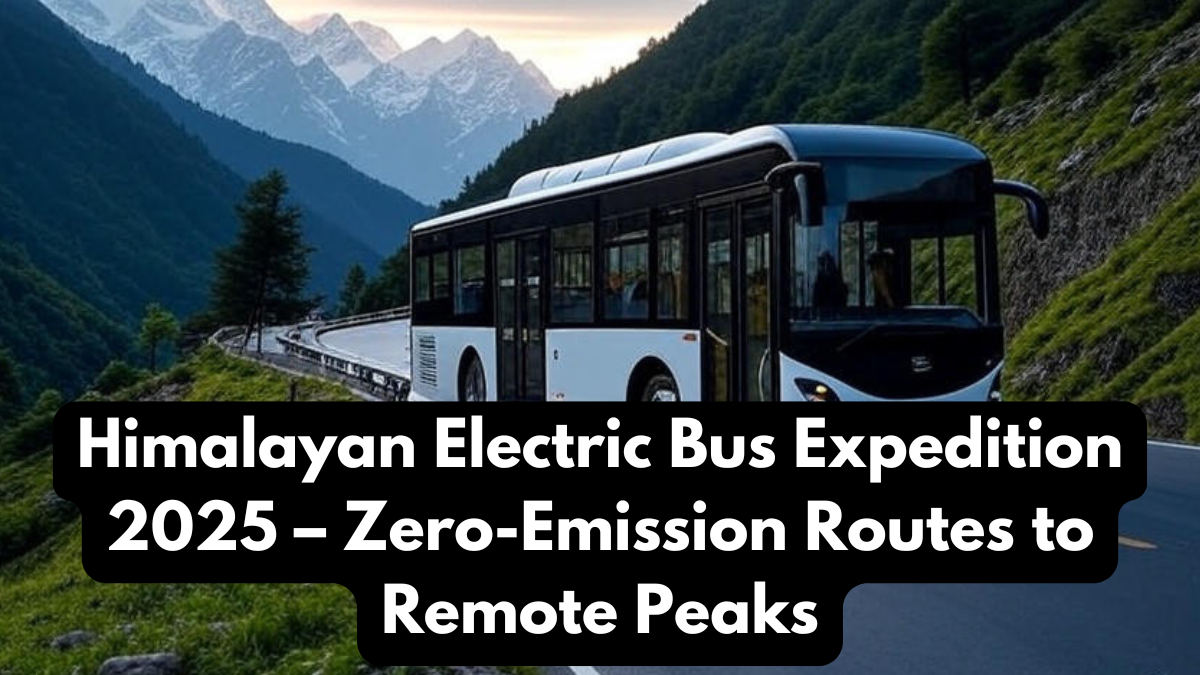In 2025, India’s push toward clean mobility has reached the highest peaks — quite literally. The Himalayan Electric Bus initiative is redefining tourism in the region by offering Zero-Emission Travel to some of the most breathtaking and remote mountain destinations. No longer do travelers have to choose between exploring the Himalayas and protecting the environment. Now, both go hand-in-hand.
This project is not just a transportation upgrade; it’s a cultural and environmental milestone. Designed to operate efficiently in challenging terrains and cold climates, the Himalayan Electric Bus ensures comfort, safety, and sustainability for every passenger.

Why Himalayan Electric Bus is the Future of Mountain Transport
The unique terrain of the Himalayas demands more than just powerful engines — it requires smart engineering and a strong commitment to eco-friendly travel. The Himalayan Electric Bus is built with high-torque motors, regenerative braking, and long-lasting battery packs, all optimized for steep climbs and winding roads.
Pairing this with Zero-Emission Travel ensures that tourism growth doesn’t come at the cost of air quality or the fragile alpine ecosystem. Beyond reducing pollution, these buses also cut noise, which helps preserve the peace and serenity that the Himalayas are famous for.
Key Features of the Himalayan Electric Bus
Here’s a quick comparison table highlighting the features that make the Himalayan Electric Bus a game-changer in Zero-Emission Travel:
| Feature | Benefit for Passengers & Environment |
|---|---|
| Zero tailpipe emissions | Protects mountain air quality |
| Long-range battery (300 km) | Ensures uninterrupted mountain routes |
| Regenerative braking system | Enhances safety on downhill slopes |
| Cold-weather battery heating | Reliable performance in freezing temperatures |
| Spacious panoramic windows | Offers immersive views during the journey |
| Onboard renewable charging | Uses solar-powered charging stations at stops |
With these capabilities, passengers can expect a seamless blend of comfort, performance, and sustainability.
How Zero-Emission Travel Benefits Himalayan Tourism
The introduction of Zero-Emission Travel in the Himalayas is expected to bring both environmental and economic benefits. By lowering carbon footprints, the initiative protects glaciers, forests, and wildlife habitats. Simultaneously, it boosts eco-tourism, attracting visitors who prioritize sustainability.
Key benefits include:
- Cleaner air and reduced respiratory issues in mountain towns
- Increased tourist interest in eco-friendly adventure packages
- New jobs in electric vehicle maintenance and renewable charging infrastructure
- Reduced dependency on imported fossil fuels for remote regions
For many, riding the Himalayan Electric Bus will become a must-have travel experience, blending the thrill of the mountains with the satisfaction of traveling responsibly.
The Road Ahead for Himalayan Electric Bus Services
With the initial phase of the project connecting major tourist hubs like Manali, Leh, and Shimla, future plans aim to expand to lesser-known high-altitude villages. This will not only make Zero-Emission Travel more accessible but also bring economic opportunities to remote communities.
Advanced plans include:
- Fully solar-powered charging depots
- Real-time bus tracking for tourists
- Partnerships with local homestays for package tours
- Winter adventure routes with heated cabin facilities
The Himalayan Electric Bus is on track to become a model for mountain transport worldwide.
Conclusion
The Himalayan Electric Bus isn’t just a vehicle — it’s a movement towards sustainable adventure. By embracing Zero-Emission Travel, India is proving that even the most challenging terrains can adopt green mobility without compromising on accessibility or comfort. As more routes open, this initiative will serve as a shining example of how tourism and environmental protection can go hand in hand.
FAQs
What is the Himalayan Electric Bus?
It is an electric-powered bus designed for high-altitude routes in the Himalayas, offering sustainable and Zero-Emission Travel.
How far can the Himalayan Electric Bus travel on a single charge?
Most models in the program can cover around 300 km per charge, making them ideal for intercity mountain routes.
Why is Zero-Emission Travel important in the Himalayas?
It protects fragile ecosystems, reduces air pollution, and supports eco-tourism without harming natural beauty.
Are there charging stations in remote Himalayan areas?
Yes, solar-powered and grid-connected charging stations are being installed along key tourist routes.
Click here to learn more